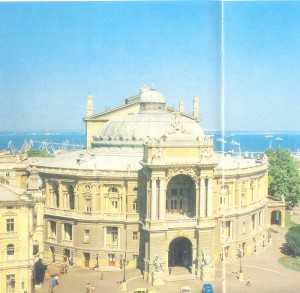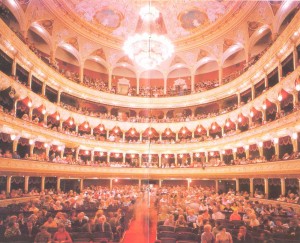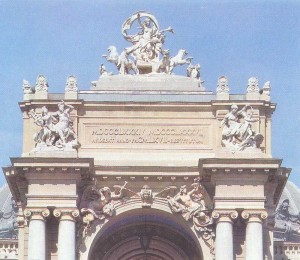The Odessa Opera and Ballet Theatre is the first house on Ulitsa Lenina (Lenin Street).
The theatre and the town of Odessa were born simultaneously. Performances were given on strips of wasteland, at the market places and in barns, with visiting companies coming from as far as Italy and France. By 1803 local opera-lovers had already staged their first opera The Miller-Magician, Deceiver and Match-Maker by the Russian composer Alexander Ablesimov.
The first city theatre was opened with great pomp and ceremony on February 10th, 1810, just fifteen years after the founding of Odessa. It was designed by the St. Petersburg architect Thomas de Thomon, and his design was given preference over that of Odessa’s own chief architect I. Frapoli.
That first theatre stood on almost exactly the same spot as today’s. The main entrance with its colonnade faced the sea. There were eight hundred seats in the hall, but only forty-four in the stalls — the rest being standing room. There were three rows of boxes in a semi-circle, and over them the gallery, but no foyer. For a long time it had no permanent company of its own, although it played host to such famous Russian actors as Mikhail Shchepkin, Pavel Mochalov, Karp Solenik and Alexander Martynov, not to mention the famous Negro tragic actor Ira Aldridge, and the famous Polish violinists the Wieniawski brothers, and the Hungarian pianist Ferenc Liszt.
A habitue of the theatre was the poet Alexander Pushkin. He referred to it in his poem Eugene Onegin;
As dusk falls softly Haste to the Opera To hear divine Rossini And Europe’s darling Orpheus …
Belinsky, Gogol, Ostrovsky, and Mickiewicz-at one time or another all visited the theatre.
In January, 1873, the theatre was gutted by fire and the people of Odessa immediately and spontaneously launched a fund-raising campaign for a new theatre. The people were no longer satisfied by even the best architect of St. Petersburg, they wanted the best in the world. The year after the fire, the city authorities announced an international contest for the best design of a theatre to seat about 1,800-2,000 people. Forty designs were presented, but none won the first prize.
It was at that time-in 1875-that the Grand Opera in Paris was completed. Talk about the beauty of the theatre and its vastness reached Odessa, and it was decided that their theatre too should be built in the new style with sculptural decorations, gilt and a fine stairway. Two Viennese architects Herman Helmer and Ferdinand Fellner, who had built fifteen theatres in different parts of Europe, including Milan’s La Scala and the Vienna Opera, were commissioned to design the Odessa Opera.
The foundation stone was laid at a special ceremony on September 16th, 1884, and three years later the theatre was completed. It was built entirely by Odessa workers with the overall guidance exercised by Odessa architects F. Gonsiorovsky, A. Bernardacci, and Yu. Dmitrenko. One of the designers, F. Fellner attended the opening ceremony.
The current story in Odessa is that when the town people learnt that the construction had cost 1.3 million gold roubles they gasped, but when they saw their new theatre they gasped anew, this time with admiration.
To this day the people of Odessa love their theatre, and continue to argue whether it holds first or second place among the world theatres built at the end of the 19th century. The argument is an emty one-the theatre is unique. Unique in its planning and in its overall harmony. The acoustics deserve special mention, the slightest whisper from the stage can be heard in every corner of the theatre, from the last row in the gallery to the first row of the stalls.
Fires in the theatres of Europe were common occurrences at the end of the last century because of the inadequacy of fire prevention measures. That is why when planning the Odessa theatre the new radial system of aisles which led from the centre to the exits was adopted. Special stairways also led to the exits from each of the tiers. All in all there were twenty emergency exits. This prompted the horseshoe shape of the facade with a cupola over the hall.
The style of Viennese baroque predominates, but it blends harmoniously with elements of the Italian Renaissance and French rococo.
The main entrance is decorated with sculptural groups taken from Greek mythology and symbolising the various theatrical forms.
Over the portico in a chariot drawn by four panthers stands Melpomene, the Muse of tragedy.
Lower, on either side of the portico are two more sculptural groups. The one on the left shows Orpheus singing to Centaurus, and on the right is the Goddess of Dance Terpsichore.
The main dates relating to the building are carved on its front MDCCCLXXXIV-MDCCCLXXXVII (1884-1887), the years of construction, and underneath MCMLXVII (1967), the year of the theatre’s reconstruction.
The sculptures at the main entrance depict scenes from the plays of the Ancient Greeks, Euripides’ tragedy Hippolytus and Aristophanes’ comedy The Birds (on the right-hand side).
In the upper niches there are busts of famous Russian composers and playwrights Gogol, Griboyedov, Pushkin and Glinka.
The balustrade is decorated with masked figures and Cupids singing, dancing and playing musical instruments.
The decor inside the hall which seats 1,633 people is rich and exquisite in detail. The stucco molding and gilt friezes combined with the red velvet of the seats and boxes, all tend to create a special atmosphere.
The ceiling is decorated with scenes from Shakespeare’s Hamlet, Twelfth Night, A Winter’s Tale and A Midsummer Night’s Dream painted by the Viennese artist Loffler.
The two main stairways are also richly decorated, the foyer of the dress-circle with its inside balconies, light arches and bridges looks elegant.
Twenty-four caryatids support the boxes of the first tier, with no two being alike. The bronze chandelier with its 208 bulbs seems ethereal yet it weighs 2tons 200kg and it is 9 m high and 4 m in diameter. The area of the stage is 500 sq. m, its width 25 m and depth 19m.
Each of the four tiers has a foyer that form a half-circle around the hall.
The theatre is air-conditioned with the temperature maintained at 22°C in the summer and 24°C in the winter.
During the war the invaders inflicted very great damage on the theatre; they took away the sets, the costumes, the music library and the rich library on the history of the theatre, music and art.
When they were leaving Odessa, the nazis set forty time bombs in the building, and the theatre was only saved due to the action of the partisans and the quick advance of Soviet troops.
On April 10th, 1944, the Red Flag of Victory was hoisted over the central balcony of the theatre and a special plaque commemorates the event.
Part of the theatrical requisites were found quite near to the city and were returned, and in October 1944, the theatre was re-opened to the public.
In the fifties the building was threatened by the settling of its site. Cracks appeared in the walls and subterranean waters penetrated its foundations. Protective measures were taken in 1956; 2,300wells were drilled around three of its sides and 6 million litres of liquid silicate glass were pumped in under pressure, thereby sealing the foundation and preventing water seepage.
In 1966-67 the building itself underwent restoration and reconstruction. The Ukrainian government allocated 4 million roubles and 9 kgs of 24 carat gold for this purpose.
On November 6th, 1967, the eve of the 50th anniversary of the Soviet state, the theatre was reopened.
The Odessa Opera and Ballet played a prominent part in the development of Russian and Ukrainian music. The Russian singers Fyodor Chaliapine, Leonid Sobinov and Antonina Nezhdanova sang on its stage, Anna Pavlova and Galina Ulanova danced there, and the actresses Maria Yermo-lova, and Maria Savina played there. So did the famous Ukrainian artists-Maria Zankovetskaya, Pavel Saksagansky, and Mark Kropivnitsky.
Famous composers conducted its orchestra such as Anton Rubenstein, Nikolai Rimsky-Korsakov and Eduard Napravnik.
Pyotr Tchaikovsky attended the premiere of his opera The Queen of Spades at the theatre in 1893 and on behalf of the Ukrainian company Maria Zankovetskaya presented the composer with a silver garland bearing the inscription “To an immortal from mortals”. A few days later in appreciation of her performance Tchaikovsky returned the compliment with a gilded garland with the inscription “To an immortal from a mortal”.
The repertoire of the theatre today includes world classics and the works of Russian and modern Soviet composers; Tchaikovsky’s Swan Lake, Sleeping Beauty, Eugene Onegin and Queen of Spades, Moussorgsky’s Khovanshchina, Borodin’s Prince Igor, Verdi’s Aida, and Un Ballo in Maschera, Leoncavallo’s Pagliacci, Gulak-Artemovsky’s Za-porozhetz za Dunayem, Lysenko’s Natalka-Poltavka, Khrennikov’s In the Storm, Shchedrin’s Anna Karenina and The Hunch-Backed Horse, Khachaturyan’s Masked Ball, and others.
The theatre stands on open ground. If you face the theatre, on your right is a garden in which a lyre has been laid out in flowers, in the evening the fountain operates, while on the other side of the alley is a water-cannon. Japanese trees whose branches resemble roots grow in the garden. The left hand side also has its garden and fountain.
In front of the theatre there is a spacious square. Two houses stood there before the war, but were destroyed by bombing. It was decided not to rebuild them leaving the square more spacious.









